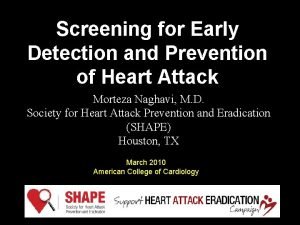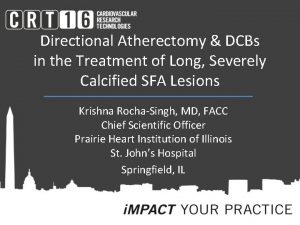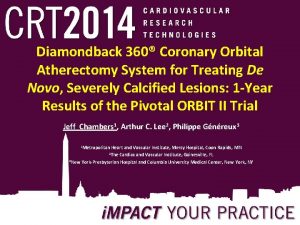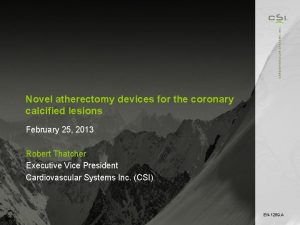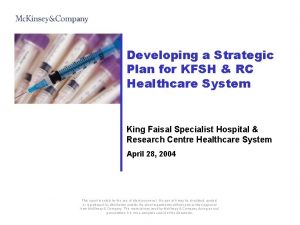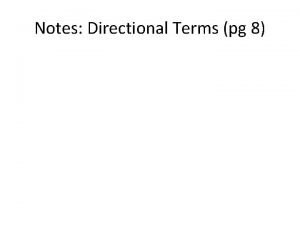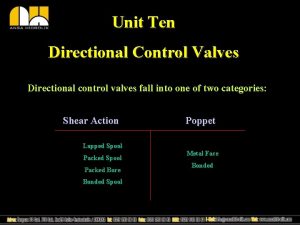Directional Coronary Atherectomy KFSH RC Experience Layth A













- Slides: 13

Directional Coronary Atherectomy KFSH & RC Experience Layth A. Mimish, J. Buraiki, M. E. Fawzy, Dunn, M. Bakhshi, B. Dajani B.

DCA u 1 st case performed in KFSH in December 1991. Total 149 cases u 21 1992 cases u 35 1993 cases u 38 1994 cases u 52 1995 cases u 3 1996/97 cases

Demographic & Clinical Data u Mean Age 52. 4+-9 years u Males/Females 136/13 u CCS class II-IV 140/149 u History of MI 83(67 QMI( u Restenotic lesions 36

DCA u LAD 121 u Circumflex 9 u Intermediate 1 u RCA 18 u 33 procedures were done to shave dissection flaps ( 24 are salvage procedures(

DCA u Mean artery size 3+-0. 5 mm u Atherocath sizes 5 6 F 7 F F 75 55 19

Additional procedures u PTCA u Thrombolysis u Stenting u PCPBS 92 4 2 3

Success & Major Comlications u Successful in 142/149 cases (95. 3%( u In 2 patients Atherocath could not be advanced despite predilatation u In 5 patients emergency CABG had to be done, with one mortality post CABG u No QMI

Minor Complications u Acute occlusion u Ventricular Fibrillation u Transient Arrhythmias u Long dissection u Haematoma u Non QMI u Coronary Embolus 4 1 2 2 2 13 5

6 Months angiographic follow up u Cathetarization performed on 139 of the 142 patients who had successful atherectomy. u Restenoses in 46/139 patients (33%(

Conclusion u DCA is an effective tool for coronary revascularization which carries a high success rate and in large vessels an acceptable restenosis rate u Technically it is more demanding than simple GOBA

Debulking Revisited Layth A. Mimish Consultant Cardiologist The Cardiovascular Consultant Group Jeddah, Saudi Arabia

Percutaneous Revascularization u Initial gain with device u Mechanism of initial gain u Lesion specific device u IVUS u Initial loss (recoil( u Injury and cellular proliferation

Percutaneous Revascularization u Initial gain with device u Mechanism of initial gain u Lesion specific device u IVUS u Initial loss (recoil( u Injury and cellular proliferation
 Csi atherectomy setup
Csi atherectomy setup Paul harris vanderbilt
Paul harris vanderbilt Directional hypothesis example
Directional hypothesis example Directional and non directional hypothesis
Directional and non directional hypothesis Directional and non directional hypothesis
Directional and non directional hypothesis Operationalised directional hypothesis
Operationalised directional hypothesis Directional and non directional hypothesis
Directional and non directional hypothesis Hypothesis testing
Hypothesis testing Directional and non directional hypothesis
Directional and non directional hypothesis Direct and indirect experience
Direct and indirect experience Imprinting psychology
Imprinting psychology Early experience vs. later experience
Early experience vs. later experience Coronary steal
Coronary steal Coronary calcium score guidelines
Coronary calcium score guidelines













